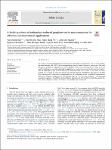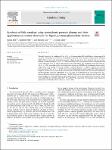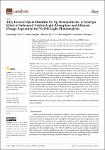Browsing by Author Van-Duong Dao
Showing results [1 - 5] / 5
The synthesis of advanced functional nanomaterials for electrochemical applications, such as water splitting, dye-sensitized solar cells (DSCs), and supercapacitor has been the topic of interest in recent years. This work presents the synthesis of ruthenium (Ru)/reduced graphene oxide (RGO) nanocomposite by using a facile and scalable liquid plasma-assisted method and its application as an electrode material in electrochemical applications for supercapacitor and triiodide reduction at counter electrodes (CEs) of DSCs. As the results, Ru nanoparticles have a size in the range of 4–10 nm that were homogenously distributed on the surface of the RGO layer. Electrochemical measurements dem... |
Solar photovoltaic systems are being widely used in green energy harvesting recently. At the same rate of growth, the modules that come to the end of life are growing fast. The solar modules contain heavy metals such as lead, tin, and cadmium, which could pollute the environment. Inspection and maintenance of solar modules are important to increase the lifetime, reduce energy loss, and environmental protection. In this research, we proposed an efficient way for inspection and classification of anomaly solar modules using infrared radiation (IR) cameras and deep neural networks. The IR cameras could capture the temperature distribution on the solar modules remotely, and the deep neural... |
A nanohybrid of titanium dioxide (TiO2) and single-walled carbon nanotubes (SWCNTs) with dual functions of collecting electrons and transparent electrode layer is synthesized by nano-cluster deposition technology. |
This work reports on the synthesis, characterization, and photocatalytic performance of the TiO2 inverse opal nanostructure (IP-TiO2) and the IP-TiO2 modified by Ag nanoparticles (Ag@IP-TiO2). The IP-TiO2 is fabricated using polystyrene spheres as the template and TiCl4 as the precursor, and the Ag@IP-TiO2 is realized by photoreduction method. The morphological, structural, and optical properties of the materials are investigated by scanning electron microscopy, X-ray diffraction, ultraviolet–visible (UV-VIS) absorption spectroscopy, and photoluminescence spectroscopy. Their photocatalytic performances are studied by the degradation of rifampicin antibiotic under the visible-light irr... |




